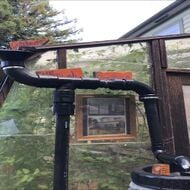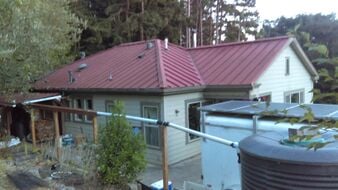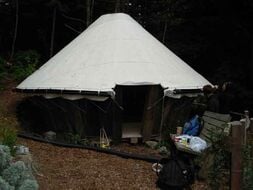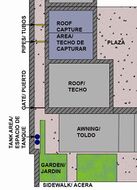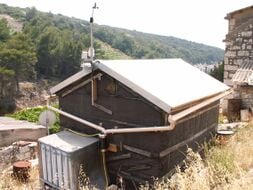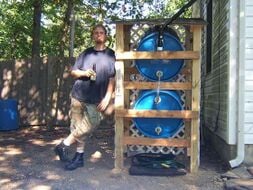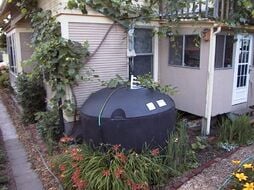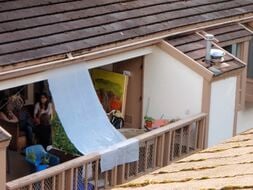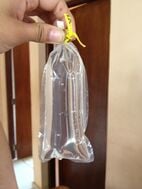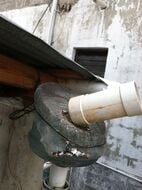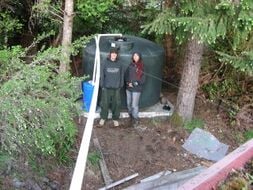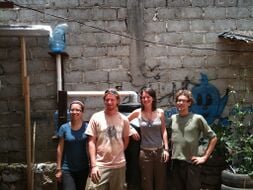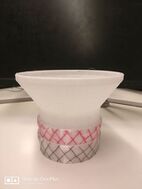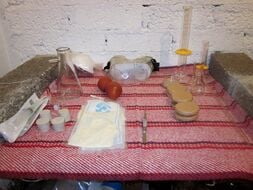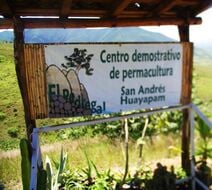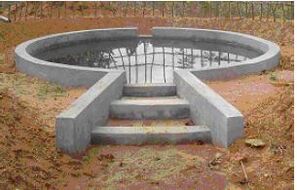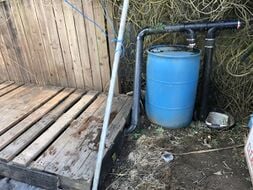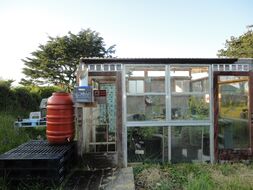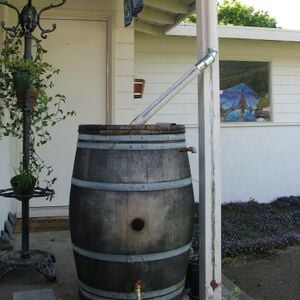
Artikel ini menjelaskan jenis pemanen air hujan umum yang dapat digunakan dalam praktik dan dapat dibuat sendiri . [1] Selain itu, panduan ini juga menyediakan beberapa konten petunjuk dasar tentang bagaimana mesin pemanen dapat dibuat dalam praktiknya. Pemanen air hujan adalah alat yang digunakan untuk mengumpulkan, atau mengumpulkan dan menyimpan air hujan. [2]
Isi
Keuntungan

- Cukup murah
- Mudah untuk dikonfigurasi ulang, diperluas, atau dipindahkan
- Dapat dipasang atau diperluas berdasarkan 'bayar sesuai pembangunan'
- Dapat diandalkan
- Kimia air mudah dikelola
- Dapat disesuaikan ukurannya dengan kebutuhan, dan diintegrasikan ke dalam konstruksi baru dengan mudah
- Sistem cadangan yang sangat bagus
- Dapat dengan mudah diikat ke sistem air sumur
- Dapat diletakkan di dalam gudang, garasi besar, atau di ruang bawah tanah
- Air masih tersedia jika Anda tidak memiliki listrik
- Pompa dapat menggunakan sistem tenaga surya atau 12 volt
- Tangki jarang membeku kecuali dalam kondisi dingin ekstrem yang berkepanjangan karena massa termalnya
- Mudah diikat ke sistem air tenaga surya
- Sebagian besar sistem dapat diakses, sehingga perbaikannya mudah
- Beberapa komponen mahal
Kekurangan
- Mengganggu secara estetika - Anda harus melakukan sesuatu dengan tangki besar
- Mungkin tidak memenuhi persyaratan peraturan bangunan setempat untuk sumber air utama untuk konstruksi baru
- Membutuhkan lebih banyak ruang tanah dibandingkan sumur untuk tangki penyimpanan dan sistem pemompaan
- Membutuhkan atap berukuran bagus
- Bahan atap dan polutan yang terbawa udara dapat mencemari air hujan
- Talang memerlukan perawatan dan pembersihan yang konstan [3]
Prinsip
Garis besar prinsip perancangan sistem pemanenan air hujan dikemukakan oleh Brad Lancaster: [4]
- Mulailah dengan observasi yang panjang dan penuh pertimbangan
- Mulailah dari puncak (titik puncak) daerah aliran sungai Anda dan lanjutkan ke bawah
- Mulailah dari yang kecil dan sederhana
- Memperlambat, menyebarkan, dan menyusup ke aliran air
- Selalu rencanakan rute luapan, dan kelola luapan tersebut sebagai sumber daya
- Maksimalkan tanaman hidup dan penutup tanah organik
- Maksimalkan hubungan yang menguntungkan dan efisiensi dengan 'menumpuk fungsi'
- Terus menilai kembali sistem Anda: 'putaran umpan balik'
Sistem
Ada banyak jenis sistem untuk memanen air hujan. Sistem yang penting adalah sistem untuk limpasan air hujan (misalnya limpasan di lereng bukit) dan sistem pemanenan air hujan di atap rumah. Jenis yang digunakan sangat bergantung pada tujuannya (penggunaan rumah tangga atau industri) dan sampai batas tertentu juga pada pertimbangan ekonomi, fisik, dan manusia. Secara umum, sistem air hujan atap paling banyak digunakan karena paling ekonomis (jika curah hujan lebih dari 254mm per tahun). [5] Untuk menentukan jumlah curah hujan yang turun di wilayah Anda, lihat Data iklim#Presipitasi .
Sistem air hujan atap rumah tangga
Tipe sistem
Saat ini, 2 jenis sistem yang umum digunakan. Ini termasuk sistem DIY dan komersial. Kedua sistem ini dikenal dengan istilah pemanen air dan hanya memerlukan sedikit pengetahuan untuk menyiapkannya (jika sistem dasar digunakan). Dalam kedua kasus tersebut, sistemnya terdiri dari tangki penyimpanan untuk menyimpan air dan pipa (untuk mengarahkan air masuk). Selain itu, peralatan bertekanan ekstra seperti bejana tekan, pengontrol pompa inline, atau pompa yang sensitif terhadap tekanan juga mungkin diperlukan. [6] Terakhir, peralatan pemurni air seperti pabrik pemurni air , lampu UV, atau peralatan distilasi terkadang (tergantung kondisi setempat [7] ) ditambahkan untuk memurnikan air yang dikumpulkan. Sistem ini kemudian disebut sistem pengolahan greywater . Sistem greywater biasanya lebih disukai daripada pemanen air biasa karena sistem ini memungkinkan sistem tidak hanya mengolah air hujan, namun juga air dari sumber lain (misalnya kloset; jika tanaman digunakan). Namun, fitur ini juga dapat dihindari dengan menggunakan lampu UV dan toilet pengomposan .
Tergantung pada keadaan setempat, sistem yang menggunakan gravitasi mungkin sudah cukup untuk memiliki sistem pengumpulan air bertekanan. [8] Dalam kasus terakhir, tidak diperlukan pompa/bejana tekan untuk memiliki sistem bertekanan. Dalam praktiknya, sistem yang dikendalikan gravitasi biasanya dibuat dengan menempatkan pemanen air pada ketinggian (misalnya atap rumah).
Sistem domestik DIY
Seiring dengan semakin populernya konservasi air , semakin banyak orang yang mulai membuat instalasi pembuatan bir sendiri. Sistem ini berkisar dari teknologi tradisional seperti tong hujan hingga sistem greywater yang lebih kompleks. Melalui Internet, rencana dan informasi konstruksi yang akurat telah tersedia. [9] [10] [11] Tergantung pada tingkat keahlian dan preferensi pribadi, sistem yang lebih mendasar (tangki air biasa dan perpipaan [12] ) atau lebih canggih (misalnya sistem bertekanan dengan pengolahan air, dll.) dipilih.
Sistem domestik komersial
Sistem komersial juga dibuat. Mereka ditawarkan oleh berbagai perusahaan... Pemanen hujan komersial dapat diperoleh baik dalam sistem bertekanan [13] maupun sistem yang diberi makan gravitasi. [14] Sistem pengolahan greywater dijual oleh perusahaan seperti Nubian Water Systems dan lainnya. [15] Sekali lagi, mereka tersedia dalam sistem bertekanan dan diberi makan gravitasi. [16] [17]
Operasi sistem
Suatu mekanisme dapat digunakan untuk mengirimkan aliran air awal ke limbah, biasanya beberapa liter pertama. Ini umumnya dikenal sebagai pengalih siram pertama , dan digunakan untuk meningkatkan kemungkinan residu partikel besar yang mungkin terakumulasi di permukaan pengumpulan Anda tersapu dari (dan bukan ke dalam) tangki penyimpanan Anda. Sistem seperti ini juga mengimbangi fakta bahwa menit-menit awal curah hujan dapat mencakup polutan yang terbawa udara yang tersapu dari langit [ diperlukan verifikasi ] , dan juga meminimalkan kontaminasi pada pasokan yang Anda tangkap. Pemeriksaan dan pemeliharaan perangkat semacam itu yang sederhana namun teratur biasanya diperlukan.
Tidak semua sistem daerah tangkapan air menggunakan fitur seperti itu. Misalnya, air hujan di wilayah pedesaan di Australia secara tradisional digunakan tanpa sistem tersebut, dan tanpa pengolahan, [ diperlukan verifikasi ] namun hal ini mungkin tidak bijaksana di lingkungan yang berbeda.
Penggunaan praktis di rumah dan lingkungan otonom
Sebagian besar gurun dan daerah beriklim sedang mendapat curah hujan setidaknya 250 mm per tahun. Artinya, rumah satu lantai dengan sistem greywater dapat memenuhi kebutuhan air sepanjang tahun hanya dari atapnya saja. Di daerah yang paling kering, mungkin diperlukan tangki berukuran 30m³. Banyak daerah yang curah hujannya rata-rata mencapai 13 mm per minggu, dan daerah tersebut dapat menggunakan tangki air berukuran sekecil 10m³.
Di banyak daerah, sulit menjaga atap tetap bersih untuk tempat minum. [18] Untuk mengurangi kotoran dan rasa tidak enak, sistem menggunakan atap pengumpul logam dan tangki "pembersih atap" yang mengalirkan 40 liter pertama. Air tangki biasanya diklorinasi , meskipun sistem osmosis balik memberikan kualitas air minum yang lebih baik.
Tangki air modern biasanya berupa tangki plastik besar. Tangki gravitasi pada menara pendek dapat diandalkan, sehingga perbaikan pompa tidak terlalu mendesak. Tangki curah yang paling murah adalah kolam berpagar atau kolam di permukaan tanah.
Mengurangi otonomi akan mengurangi ukuran dan biaya waduk. Banyak rumah otonom yang dapat mengurangi penggunaan air di bawah 10 galon AS per orang per hari, sehingga pada musim kemarau selama sebulan, air dapat disalurkan dengan biaya murah melalui truk. Pengiriman sendiri sering kali dapat dilakukan dengan memasang tangki air berbahan kain yang sesuai dengan bak truk pick-up.
Akan lebih mudah jika menggunakan tangki sebagai penyerap panas atau perangkap untuk pompa panas atau sistem pendingin udara; namun hal ini dapat membuat air minum dingin menjadi hangat, dan pada tahun-tahun kering dapat menurunkan efisiensi sistem HVAC.
Sistem industri
Air hujan juga dapat digunakan untuk mengisi ulang air tanah , dimana limpasan di dalam tanah dikumpulkan dan dibiarkan diserap, sehingga menambah air tanah . Di AS, air hujan di atap rumah dikumpulkan dan disimpan di bak. [19]
Di India, ini termasuk Bawdis dan johads, atau kolam yang menampung limpasan air dari sungai kecil di wilayah yang luas. [20] [21] [22]
Di India, waduk yang disebut tanka digunakan untuk menyimpan air; biasanya mereka dangkal dengan dinding lumpur. Tanka kuno masih ada di beberapa tempat. [23]
Desain dan infrastruktur perkotaan air hujan
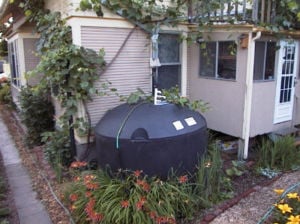
Hujan adalah sumber daya penting yang mengisi sungai dan mengisi kembali persediaan air permukaan dan air tanah (lihat pengisian ulang air tanah ). Sayangnya, beton dan permukaan kedap air lainnya yang membentuk sebagian besar lanskap (sub) perkotaan saat ini mengganggu siklus hidrologi dan mencegah terjadinya proses infiltrasi alami. Banyak kota juga dilanda infrastruktur yang menua dan pipa bocor. Kota-kota dapat kehilangan sebanyak 40 persen air yang diolah karena kerusakan pipa dan peralatan lainnya. [24] Air yang "hilang" ini memperburuk kekurangan air dan dapat menyebabkan masyarakat berinvestasi pada infrastruktur air baru yang mahal (misalnya bendungan dan pengalihan sungai). Komunitas seperti Holliston, Massachusetts berencana untuk memaksimalkan ruang hijau untuk pengisian ulang air dan sedang mengembangkan sistem pengelolaan air limbah yang mengembalikan air olahan dalam jumlah besar ke masyarakat untuk penggunaan lokal daripada menyalurkan limbah sejauh 50 hingga 100 mil ke kota di hulu untuk diolah. [25]
Selain itu, masyarakat dapat memanfaatkan model peraturan untuk menciptakan penyangga sungai; desain jalan, halaman sekolah dan tempat parkir; dan rekomendasi lanskap perumahan untuk meningkatkan porsi curah hujan yang diserap dan mengisi kembali pasokan air tanah. Ketika masyarakat memaksimalkan potensi infiltrasinya, mereka dapat mengurangi ketergantungan mereka pada mekanisme infrastruktur air tradisional, seperti bendungan. Laporan tahun 2002 oleh American Rivers, Natural Resources Defense Council dan Smart Growth America yang berjudul Paving Our Way to Water Shortages [26] merekomendasikan hal-hal berikut:
- Mengalokasikan lebih banyak sumber daya untuk mengidentifikasi dan melindungi ruang terbuka dan kawasan perairan kritis;
- Menerapkan manajemen pertumbuhan yang baik dengan mengesahkan undang-undang yang lebih kuat dan komprehensif yang mencakup insentif untuk pertumbuhan cerdas [27] dan area pertumbuhan yang ditentukan;
- Mengintegrasikan pasokan air ke dalam upaya perencanaan dengan mengkoordinasikan pembangunan jalan dan proyek konstruksi lainnya dengan kegiatan pengelolaan sumber daya air;
- Berinvestasi pada komunitas yang ada dengan merehabilitasi infrastruktur sebelum membangun infrastruktur baru – sebuah strategi pembangunan “perbaiki dulu”;
- Mendorong pembangunan kompak yang memadukan pembangunan ritel, komersial dan residensial;
- Gantikan infrastruktur saluran pembuangan dan terowongan beton – yang mengalirkan air hujan terlalu cepat ke saluran air – dengan teknik pembangunan berdampak rendah yang dapat mengisi kembali air tanah. Hal ini mencakup penyimpanan di lokasi yang memungkinkan air meresap ke dalam tanah asli yang permeabel atau teknik bioteknologi yang memfasilitasi penguapan dan transpirasi air hujan; Dan
- Mencurahkan lebih banyak uang dan waktu untuk penelitian dan analisis dampak pembangunan terhadap sumber daya air, dan membuat informasi ini dapat diakses oleh masyarakat.
Studi kasus yang sukses
Petrolina, Brasil
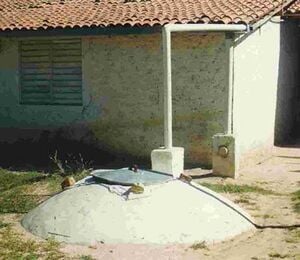
Iklim: Semi Kering; Air hujan digunakan sebagai sumber utama
Petrolina berada di sabuk semi kering di Timur Laut Brasil. Curah hujan rendah dan sangat bervariasi dari tahun ke tahun. Solusi terhadap masalah kelangkaan air adalah penggunaan tangki besar (10.000-20.000 liter) yang dapat menyimpan cukup air untuk memenuhi kebutuhan rumah tangga yang hemat hingga musim hujan berikutnya. Tangki-tangki tersebut biasanya disediakan oleh LSM karena bangunan besar yang diperlukan di daerah yang sangat gersang ini memerlukan biaya lebih dari $200 dan tidak terjangkau oleh penduduk setempat.
Badulla, Sri Lanka
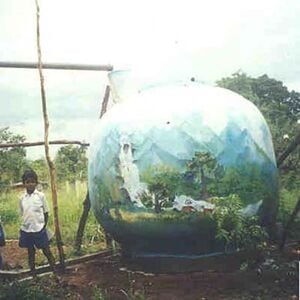
Iklim: Tropis, Bimodal; Air hujan digunakan sebagai sumber utama
Kota Badulla terletak di daerah perbukitan di Sri Lanka. Sumber air tanah sedikit dan cenderung berada di dasar perbukitan. Untuk mengurangi beban membawa air, pemerintah setempat menyediakan 5.000 liter tangki ferrocement , dengan biaya sekitar $150 yang digunakan untuk sebagian besar pasokan air rumah tangga. Tangki-tangki tersebut kini diadopsi secara nasional untuk digunakan di wilayah di mana akses terhadap sumber air terlindung lainnya sulit dilakukan.
Rakai, Uganda
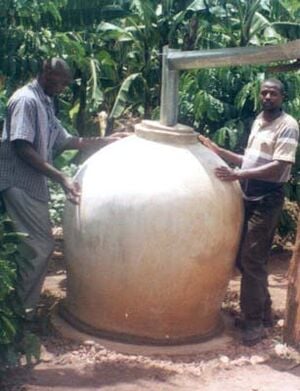
Iklim: Tropis, Bimodal; Air hujan digunakan sebagai sumber tambahan
Rakai berada di perbukitan selatan Uganda. Daerah ini memiliki pola curah hujan bimodal sehingga musim kemarau hanya berlangsung selama 2 bulan. Sebuah kelompok perempuan lokal telah dilatih membuat tangki oleh kelompok perempuan di Kenya dan telah membuat sejumlah besar toples kecil (700 liter) untuk menambah penggunaan air mereka, terutama pada musim hujan ketika mereka menyediakan sebagian besar kebutuhan air. Biaya sistem yang di bawah $70 dibiayai oleh dana bergulir mandiri.
Khon Kaen, Thailand
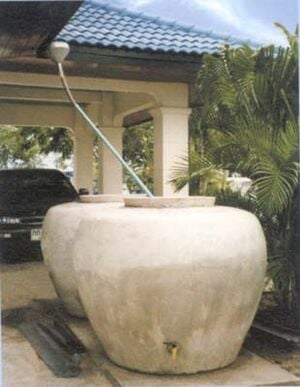
Iklim: Tropis, Muson; Air hujan digunakan sebagai sumber utama
Thailand Timur Laut merupakan salah satu tempat diseminasi pemanenan air atap terbesar di dunia. Teknologi pilihannya adalah "toples Thailand" berkapasitas 1-2.000 liter. Proyek ini melewati beberapa tahap dengan mengurangi intervensi luar, yang akhirnya menjadi pasar komersial yang memproduksi toples dalam jumlah besar dengan harga kurang dari $30. Hal ini mendorong masuknya stoples air hujan dengan cepat dan saat ini sebagian besar rumah, kaya atau miskin , memiliki setidaknya satu stoples. [1]
Asosiasi Sistem Penangkapan Air Hujan Internasional (IRCSA)
Tujuan IRCSA bertujuan untuk mempromosikan dan memajukan teknologi sistem tangkapan air hujan sehubungan dengan perencanaan, pengembangan, pengelolaan, ilmu pengetahuan, teknologi, penelitian dan pendidikan di seluruh dunia; membentuk forum internasional bagi para ilmuwan, insinyur, pendidik, administrator dan mereka yang berkepentingan di bidang ini. http://www.ircsa.org/
Tujuan utama IRCSA adalah:
- Promosi dan kemajuan Teknologi Sistem Penangkapan Air Hujan sehubungan dengan perencanaan, pengembangan, pengelolaan, ilmu pengetahuan, teknologi, penelitian dan pendidikan di seluruh dunia.
- Pembentukan forum internasional bagi para ilmuwan, insinyur, pendidik, administrator dan semua pihak yang secara langsung atau tidak langsung terlibat dalam program sistem tangkapan air hujan untuk menghubungkan semua pihak yang bekerja di bidang ini sehingga informasi dan pengalaman dapat dibagi.
- Penyusunan pedoman internasional tentang penggunaan teknologi Sistem Penangkapan Air Hujan dan pemutakhiran serta penyebaran informasi ini.
- Kerjasama dan dukungan Program Internasional di bidang Sistem Penangkapan Air Hujan termasuk kerjasama dengan organisasi lain yang mempunyai kegiatan yang sama.
- Dukungan dan kelanjutan dari rangkaian Konferensi Sistem Tangkapan Air Hujan Internasional.
Proyek terkait
Lihat juga
- To Catch the Rain – buku tentang pemanenan air hujan berdasarkan konten Appropedia
- Perhitungan dasar pengumpulan air hujan
- Tinjauan literatur tangkapan air hujan
- Pemanenan air hujan – informasi pengaturan sistem pemanenan air hujan
Tautan eksternal
- Wikipedia:Pemanenan air hujan
- Metode baru pemanenan air hujan
- Legalitas pengumpulan air hujan menurut negara bagian di Amerika Serikat
- Komunitas pemanen air hujan HarvestH2o
- Situs web Pemanenan Air Hujan dari Layanan Penyuluhan A&M AgriLife Texas
- Produk pengumpulan air hujan
- Asosiasi Sistem Penangkapan Air Hujan Internasional
- Fakta Pemanenan Air Hujan
- Mengurangi risiko Penyakit Legiuner pada pemanenan air hujan
- Forum tangkapan air hujan di Permies.com
Referensi
- ↑ Informasi pemanenan air hujan terdiri dari informasi yang dihapus dari artikel pemanenan air hujan Wikipedia
- ^ Definisi pemanenan air hujan
- ^ http://web.archive.org/web/20110228150726/http://www.thefarm.org:80/charities/i4at/surv/raincat.htm
- ^ https://www.harvestinggrainwater.com/store/
- ^ Earthship Volume 2: Sistem dan komponen
- ^ Peralatan bertekanan terkadang diperlukan untuk sistem pengumpulan air hujan
- ↑ Perawatan air terkadang tidak diperlukan
- ^ Sistem yang diberi gravitasi melalui perbedaan ketinggian juga terkadang cukup untuk sistem pengumpulan air bertekanan
- ^ Informasi pemanenan air atap (ebook,...)
- ^ Informasi pemanenan air VillageEarth
- ^ Daftar konkret sistem pemanen air hujan DIY dan cara membuatnya
- ^ Pemanen air hujan buatan sendiri yang diberi makan gravitasi dari Peternakan
- ^ Pengoperasian sistem pemanen air Rainman
- ^ Pemanen hujan yang diberi makan gravitasi
- ^ Sistem pemanenan air hujan komersial lainnya
- ^ Sistem air abu-abu dapat digunakan dalam bentuk bertekanan yang diberi makan gravitasi
- ^ Contoh sistem greywater yang diberi makan gravitasi
- ^ Cistern Design, University of Alaska, direferensikan pada 27-12-2007
- ^ Sistem Pemanenan Air Hujan dan Pemurnian Air.
- ^ The River maker, New Scientist, 7 September 2002. Edisi online (artikel lengkap dengan berlangganan)
- ^ Rima Hooja: "Menyalurkan Alam: Hidraulik, Sistem Pengetahuan Tradisional, dan Pengelolaan Sumber Daya Air di India – Sebuah Perspektif Sejarah"
- ↑ Mengisi ulang air tanah dengan cara ini diklaim tidak hanya meningkatkan ketersediaan air tanah sepanjang tahun, namun juga menghasilkan vegetasi yang lebih kaya. (Tadinya saya akan menambahkan ini dan menyadari bahwa saya tidak tahu apakah ini merupakan efek langsung dari permukaan air yang lebih tinggi, atau apakah mereka menggunakan air tanah untuk mengairi, sehingga menyebabkan penghijauan. --Singkong2005
- ^ Rima Hooja: "Menyalurkan Alam: Hidraulik, Sistem Pengetahuan Tradisional, dan Pengelolaan Sumber Daya Air di India – Sebuah Perspektif Sejarah"
- ^ Bisnis NYCWasteLe$$, Otoritas Pelabuhan New York dan New Jersey di Bandara LaGuardia, Konservasi Air: Toilet, Oktober 2001, http://www.nycwasteless.com/gov-bus/Casestudies/lgacase2.htm (24 Januari 2002 ).
- ^ Asosiasi DAS Sungai Charles, Proyek Zonasi Lingkungan: Mempertahankan Sumber Daya Air di Holliston, http://www.craw.org (17 Januari 2002).
- ^ American Rivers, Dewan Pertahanan Sumber Daya Alam, dan Smart Growth America. Membuka Jalan Menuju Kekurangan Air: Bagaimana Ketersebaran Memperburuk Dampak Kekeringan. Washington, DC: Sungai Amerika, 2002.
- ↑ Meskipun pertumbuhan cerdas telah digunakan dalam berbagai cara, dalam konteks ini pertumbuhan cerdas mengacu pada sepuluh prinsip pertumbuhan cerdas yang dikeluarkan oleh Smart Growth America yang berkisar dari investasi infrastruktur seperti jalan raya dan saluran pembuangan hingga insentif ekonomi untuk mendorong revitalisasi komunitas yang ada. Daftar lengkap sepuluh prinsip dapat ditemukan di http://www.smartgrowthamerica.org .
